Owls of Brazil
In Brazil, owls are often associated with mystery, mysticism and fear, considered by many to be creatures of bad omens. Especially because they are silent birds that only appear at night and lurk with their big eyes, myths have influenced the perception of these animals - for example, the one that says that the owl heralds death.
Although some indigenous tribes also see them as ominous birds or doomed souls, other peoples see them as protective spirits, sacred animals that bring good luck, or symbols of wisdom.1
Indeed, owls are animals that captivate us with their appearance and curious hooting. But far from being associated with myths, the physical peculiarities of these birds exist for only one purpose - to be expert hunters.
Sharp sight and hearing
Owls are highly visual animals and use their sharp eyes to hunt both by day and by night — depending on the species. Although they are not able to see in total darkness, they have tapetum lucidum (a membrane that reflects light) and a large pupil to let more light into their eyes. Thus, they can see 2 to 7 times more than humans in dark environments2.
Owls differ from other birds mainly by having their eyes facing forward, which favors depth perception. But such eye positioning makes their vision limited when compared to other birds that have eyes on the sides of their heads. However, owls can compensate for this loss of visual field by being able to rotate their necks up to 270°.3
Because they cannot move their eyes, all birds need to constantly move their heads to compensate for their blind spots. Owls, however, have a greater deficiency in their field of vision and need to move more.4 2 In addition, owls can visualize small rodents at a great distance, but are unable to see definitively anything very close to their eyes.5
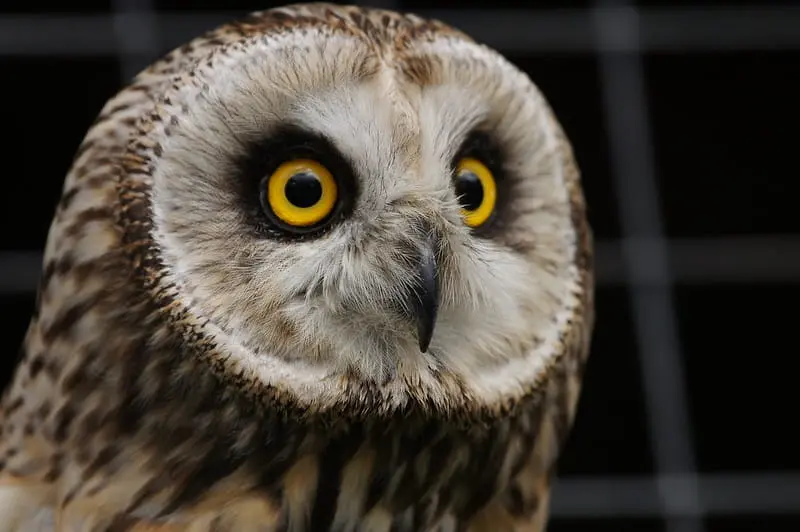
Owls also have very good hearing, which is often more important than sight when hunting. Although they cannot see in total darkness, their hearing is so good that they can hunt using only the sounds emitted by their prey as they walk.
In many species, the facial feathers form a disc around the eyes or the entire face, called a “facial disc,” which amplifies sound and helps direct it to the sides of the face where the ears are located. These feathers are so important that removing them would damage your hearing.
The shape of the disc can be adjusted as needed to better direct sound to the ears.3 Owls of the genera Tyto and five other genera of the Strigidae family (Bubo, Strix, Aegolius, Pseudoscops and Asio) have ears that are asymmetrical in shape, position, and size. This characteristic allows them to distinguish small differences in the sounds around them and to know the exact location of their prey.2
Many species have ear-like feathers on the top of their heads. However, these are not related to hearing — they are merely for ornamentation, camouflage, visual communication, and interspecies recognition.4
Flying and Hunting
Although slower than other raptors, owls have the ability to fly almost silently. The tips of their wings have small bristles that help direct the air, reducing noise and turbulence. They also have a soft composition that absorbs the sound emitted by the flapping of their wings. This adaptation helps them hunt by allowing them to approach their prey undetected.2 4
Owls usually feed on small mammals, insects, birds, and some reptiles. After capturing and killing their prey with their powerful claws, they swallow it whole, tearing it apart only if it is too large to swallow all at once.
Due to their biology, owls cannot digest bones and fur, so they regurgitate one or two balls of leftover food each day.4
Diversity
There are about 220 species of owls distributed throughout the world, except for the polar ice caps and remote islands. In Brazil, there are about 23 species of owls, very different from each other, ranging from the 60 g (0.13 lb) of the East Brazilian pygmy owl, to the more than 2 kg (4.4 lb) of the South American great horned owl. They are found in all biomes of the country, but the greatest diversity is found in the Atlantic Forest of the southern and southeastern regions, with up to 17 species.
All these species are divided into two families — Tytonidae and Strigidae, but only the Barn owl belongs to the Tytonidae and all other species belong to the Strigidae family.6 4
Tytonidae
Barn owl (Tyto furcata)
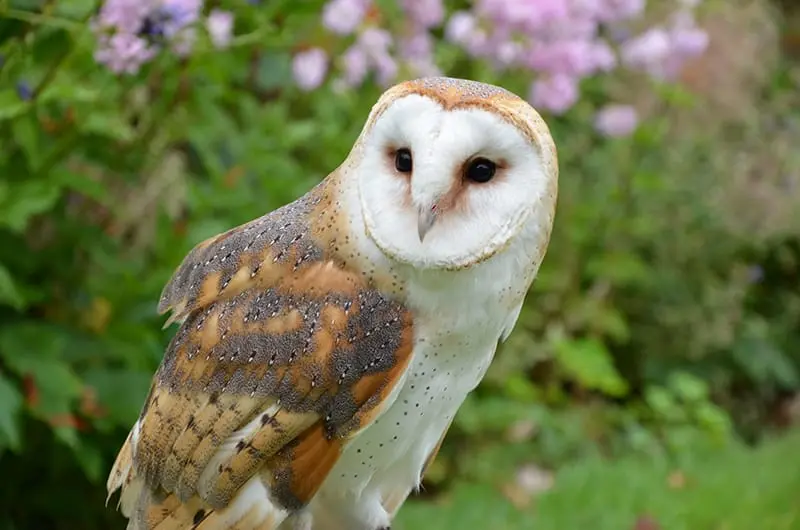
Owls of the family Tytonidae are among the most widespread birds in the world, occurring on all continents except Antarctica. They usually live in open and semi-open areas such as fields, scrubland and prairies. They are found throughout Brazil, especially in the south and southeast, and to a lesser extent in the Amazon rainforest.
Of the approximately 17 species of this family distributed around the world, only Tyto furcata inhabits Brazil. Tyto furcata was considered a synonym of Tyto alba until 2008, but after analyzing various genetic differences, it became an independent species.
The number of subspecies is uncertain, ranging from 4 to 10. In Brazil, two subspecies are considered: T. f. hellmayri and T. f. tuidara. Although these two subspecies are distinguished mainly by color and size, some researchers do not consider them to be distinct species, and further genetic analysis is needed for a more precise definition.
They can reach just over a meter in wingspan and are considered medium-sized owls. They are an easily adaptable bird, found in both rural and urban environments, often nesting high in churches, buildings and attics. They are easily recognized by their rounded face, which has a boundary formed by their feathers, making it resemble the shape of a heart or an apple cut in half. 7 8 9
Strigidae
Screech owls (Megascops)
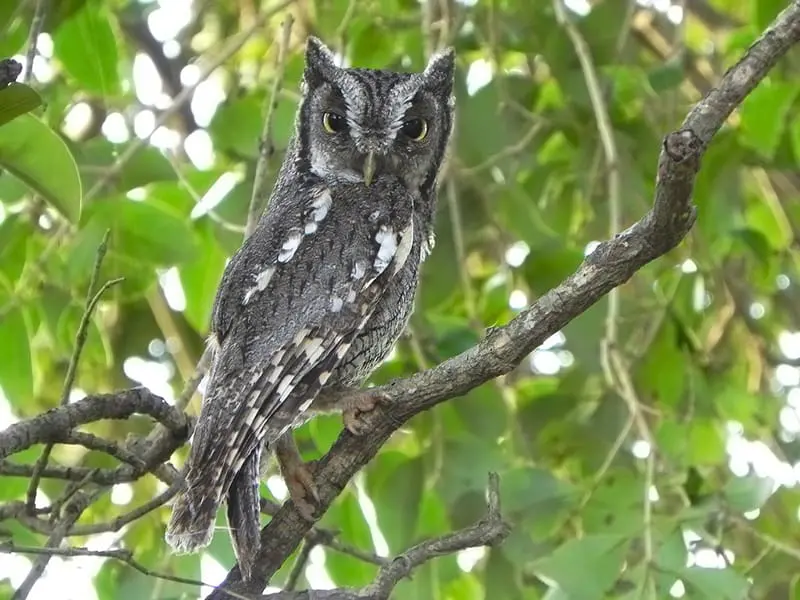
Owls of the genus Megascops are native to the Americas. They are distributed in 23 species, of which six Screech owls are distributed throughout Brazil. They are known as Tropical screech owl (M. choliba), Tawny-bellied screech owl (M. watsonii and M. usta), Black-capped screech owl (M. atricapilla), Long-tufted screech owl (M. sanctaecatarinae) and Middle American screech owl (M. guatemalae).
All members of this genus are agile, compact, and small, ranging in length from 6 to 11 inches (17 to 30 cm), depending on the species. They have small tufts of feathers above their heads.
The owls of this genus are difficult to distinguish at first glance even by experts, but can be identified mainly by the different vocalizations.10 Although the same method of identification based on the different vocalizations is considered for the Tawny-bellied screech owls, many authors consider them to be the same species.11
Crested owl (Lophostrix cristata)
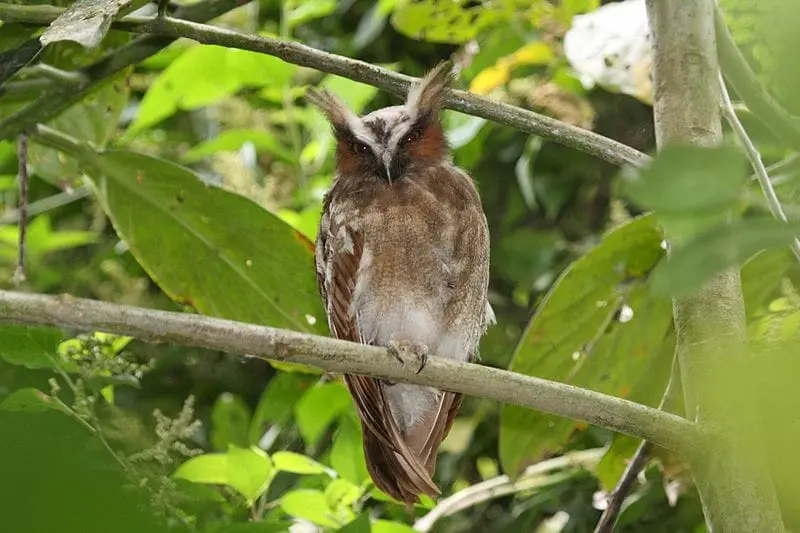
Only the Crested owl (Lophostrix cristata) belongs to the genus Lophostrix. It is about 40 cm long and has a characteristic white plumage on its head and feathers that contrasts with the brown plumage of its body. When disturbed, it raises its feathers in a “V” shape. Another notable characteristic of this species is its hoarse, deep call.
The Crested owl is found throughout Central and South America. In Brazil, it is found only in the Amazon rainforest, where it roosts on branches near rivers and lakes.12
Spectacled owls (Pulsatrix)
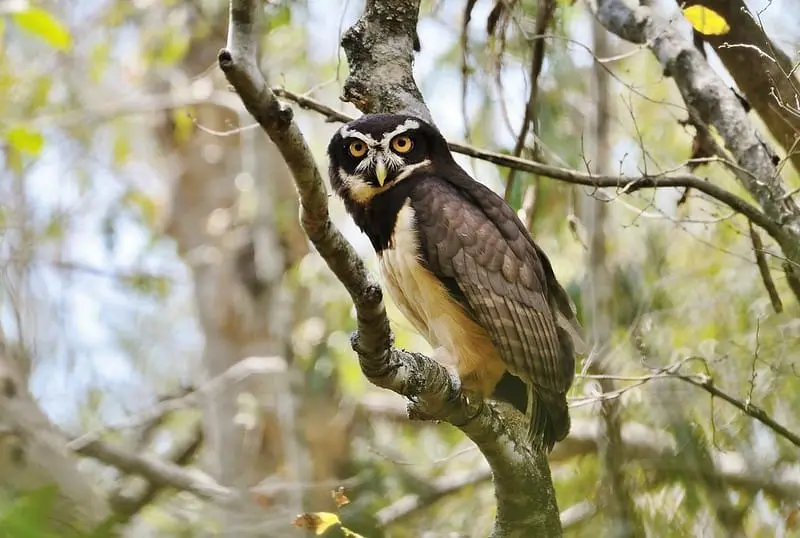
In addition to being easily recognized by their characteristic song, Spectacled owls have a black head with a cross-shaped mark that defines the center of the face above the beak and between the eyes, resembling the frame of a pair of glasses.
There are three species of Spectacled owls, two of which are found in Brazil — the Tawny-browed owl, (P. koeniswaldiana) and the Spectacled owl (P. perspicillata), which has five or six subspecies, two of which are found in Brazil: P. p. perspicillata and P. p. perspicilla.
However, considering differences in song and plumage, P. p pulsatrix is considered by some authors as a fourth species, called Pulsatrix pulsatrix. However, other authors consider that the data analyzed are insufficient for a separation to be made, leaving its classification uncertain.13
The Spectacled owl (P. perspicillata) is found only in the South of Brazil. The Tawny-browed owl, (P. koeniswaldiana), on the other hand, is found throughout the Atlantic Forest region.14 These are owls weighing more than one kilogram and measuring 40 to 55 cm in length, the tawny-browed ones being smaller and lighter.
Great horned owl (Bubo virginianus)
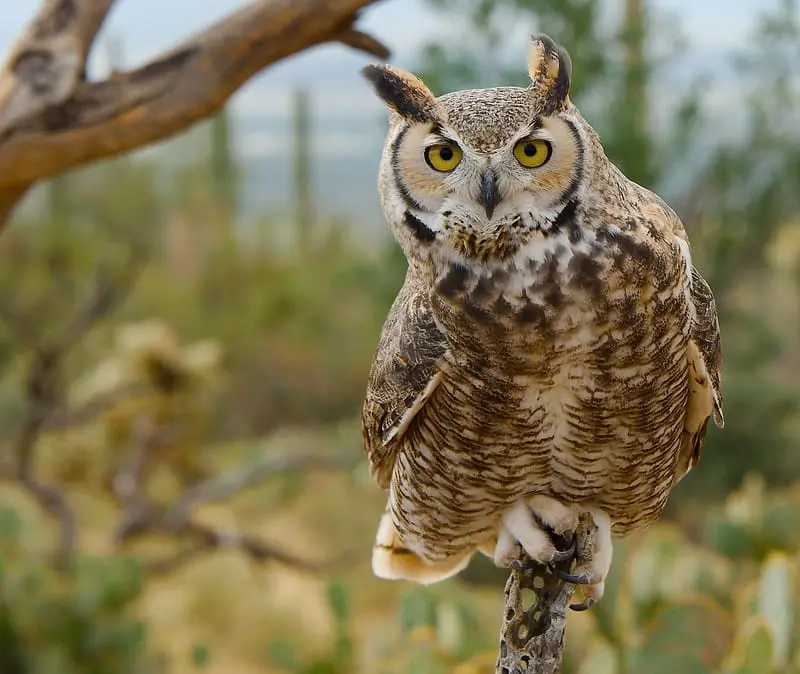
The Great horned owl, also known as tiger owl, or hoot owl, is the largest owl in Brazil and one of the largest in the Americas, measuring up to 60 cm (24 inches) long and weighing over 2.5 kg (5.5 lb).15 In addition to its size, it is characterized by large tufts of feathers on the top of its head.
It is an extremely adaptable owl, inhabiting semi-open areas, savannah, rocky areas, or rural regions,16 making it one of the most widely distributed species on the continent - although it is not common in the Amazon rainforest. In Brazil, it is found mainly in the south and southeast.
Mochos (Asio)
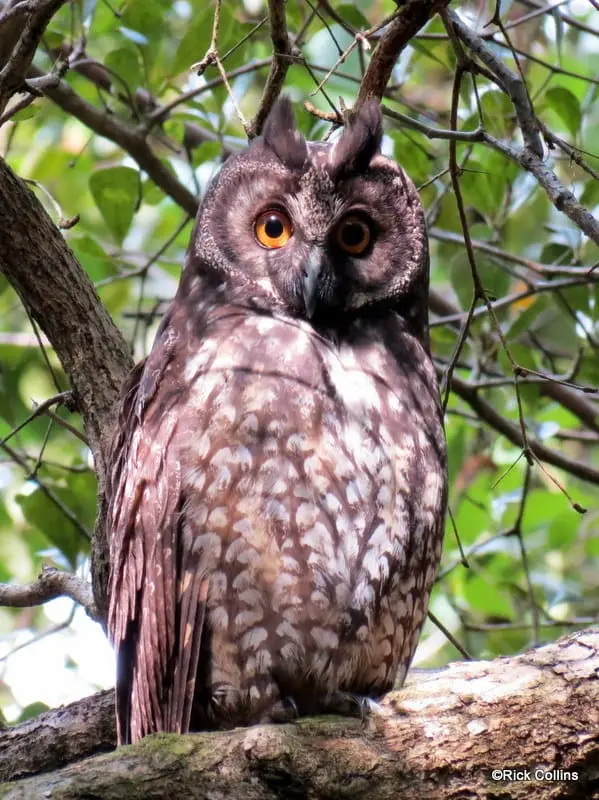
They are medium to large-sized owls, measuring between 30 and 45 cm. They live near fields, pastures, and well-wooded urban areas. The genus Asio is composed of nine species spread over much of the world, being one of the birds with the widest geographic distribution. In Brazil, there are three species found mainly in the south and southeast, and less frequently in the Amazon rainforest.
The Great Horned Owl (A. clamator) is light-colored with large black spots all over the body and a dark outline around the face. It also has large tufts on the top of its head. The Stygian owl (A. stygius), on the other hand, has tufts of black feathers that stand fully erect on top of the head when alarmed — resembling horns. Also, when in contrast to light, their eyes can reflect a reddish color, which can give an unusual appearance. Because of this, it is known in Brazil as the “Devil Owl”.
The Short-eared owl (A. flammeus) is the most different of the owls of its kind. It has small ears on top of its head that are difficult to see, is partly diurnal, and its diet consists almost exclusively of mice.
Strix Owls
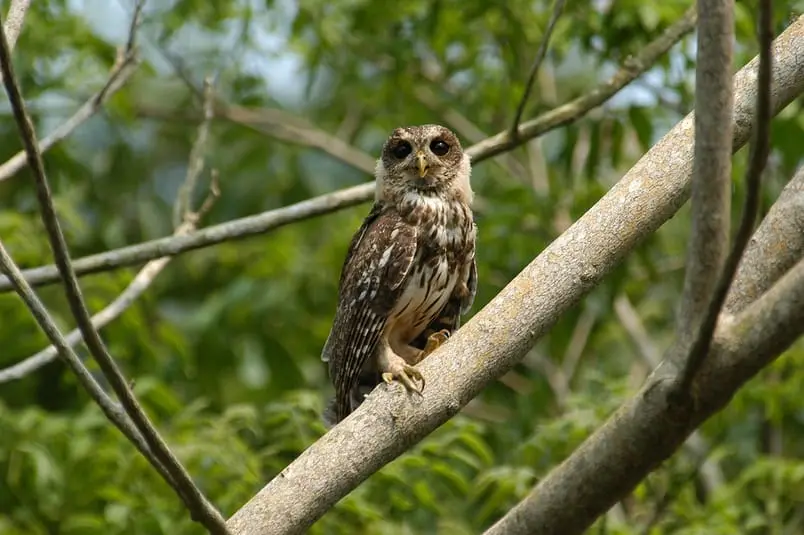
There are about 22 species of owls of the genus Strix scattered around the world. They are considered medium-sized, with a length between 30 and 40 cm (12 and 16 inches). In Brazil, there are only three little known species: Rusty-barred owl (S. hylophila), found in the Atlantic Forest of the South and Southeast regions; Mottled owl (S. virgata) and Black-banded owl (S. huhula), which inhabit all of Brazil — but mainly the Atlantic Forest of the South and Southeast regions.
The Mottled Owl and the Rusty Barred Owl can be distinguished by the horizontal stripes on the chest of the Rusty Barred Owl and the vertical stripes on the chest of the Mottled Owl. The Rusty-barred Owl is one of the few Brazilian owl species listed as “Near Threatened” in the Red List of the International Union for Conservation of Nature (IUCN). The Black-banded owl, on the other hand, according to ICMBIO (2014), is classified at different levels of threat according to the Brazilian states.17
Burrowing owl (Athene cunicularia)
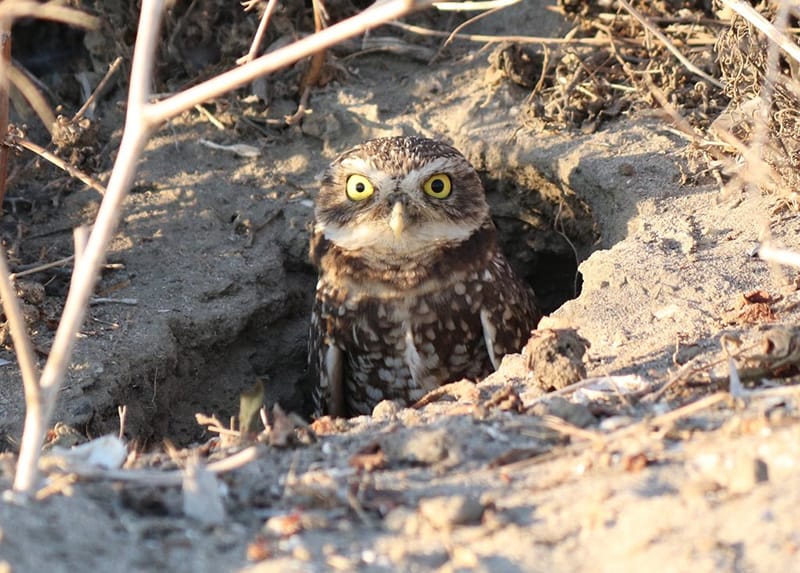
It is the best known and most abundant owl in Brazil, found throughout the country, including urban areas, but is rare in densely forested areas such as the Amazon rainforest. It is a small owl, about 20-25 cm long.
Unlike most of the owls mentioned here, it is active both during the day and at night. It also has the unusual habit of living and laying its eggs in burrows in the ground. It feeds mainly on insects, arachnids, and less frequently on small vertebrates.18
Pygmy owls (Glaucidium)
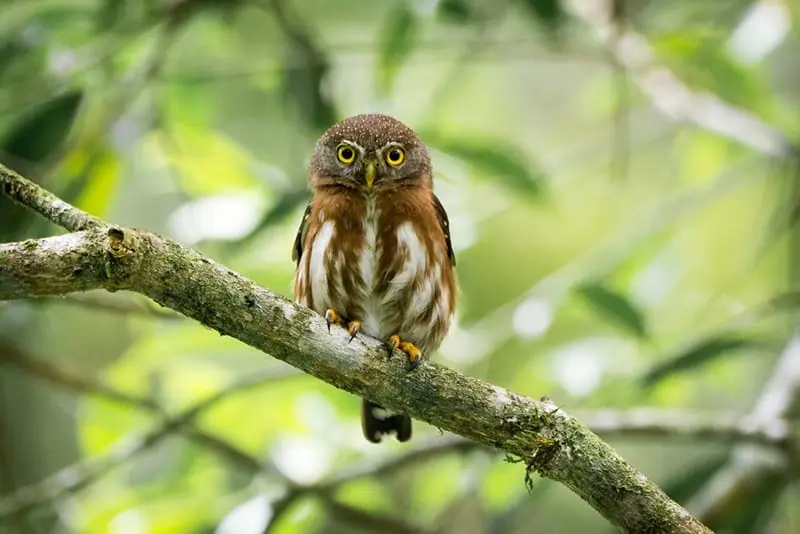
They are among the smallest owls in the world, ranging from 6 to 8 inches (15 to 20 cm) in length. They are partially diurnal and have distinctive “false eyes” on the nape of the neck, which serve to confuse their prey (mostly raptors).
There are about 30 recognized species distributed throughout the world.In Brazil, only four are known, but one of them, the Pernambuco pygmy owl (G. mooreorum), was declared extinct in 2014.19
The Amazonian pygmy owl (G. hardyi) lives in the Amazonian Forest.20 The East Brazilian pygmy owl (G. minutissimum), on the other hand, is present only in the Atlantic Forest.21 The Ferruginuos pygmy owl (G. brasilianum) is distributed throughout Brazil, but less frequently in the Amazon Rainforest.22 Because of their small size and habit of living in tree canopies, they are difficult owls to see even during the day; therefore, they are poorly studied species.
Buff-fronted owl (Aegolius harrissii)
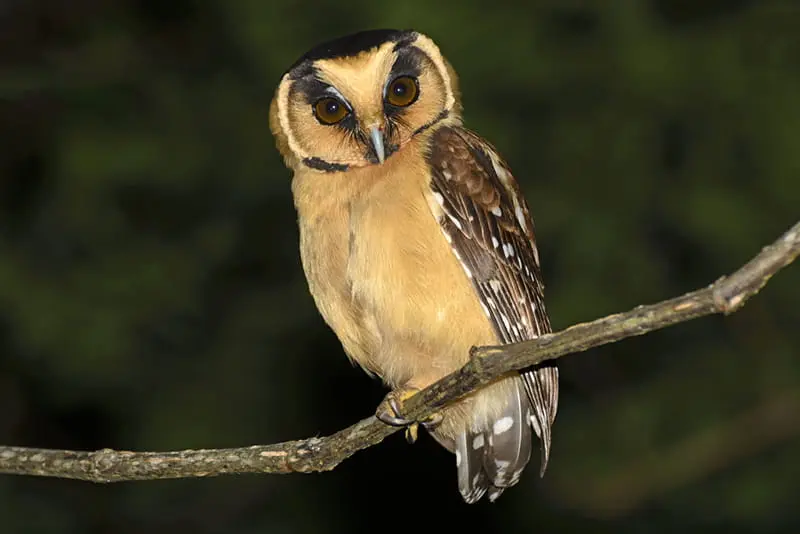
Although it occurs throughout the eastern region of Brazil, especially in the southeast (where it inhabits open forests, cerrado, and fields), it is a difficult species to find; therefore, its behavior and habits are little known.
It measures 17 to 25 cm (7 to 10 in) and weighs between 57 and 152 g (2 to 5 oz) — females are larger and heavier. It is easily recognized by its light brown color and the black stripe around its eyes and under its bill.
There are three subspecies, but only the A. harrisii iheringi inhabits Brazil.
Conservation
Like other predators at the top of the food chain, owls help control insect and rodent populations in both natural and human-altered environments — since they can consume thousands of these animals throughout the year. Because they act in pest control, the preservation of these birds is extremely important. 2
Most of the unnatural deaths of these birds result from hunting, poisoning by pesticides, collisions with windows, being run over by cars, and accidents with electric fences and barbed wire. In addition, degradation of their natural environment also drastically reduces their numbers, especially of species that live in forests.6 4
Although most owls are listed as “Least Concern” on the International Union for Conservation of Nature (IUCN) Red List, many are still persecuted and killed, especially the more common ones that live close to man, such as the barn owl — a big target of bad omen beliefs. Raising awareness and spreading correct information about these animals is an important part of demystifying and collaborating with the survival of owls.
Read more:
